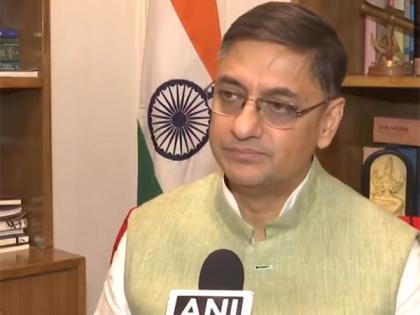"Multiple taxes to one tax, GST regime made this possible", PM's Economic Advisory Council member Sanjeev Sanyal
By ANI | Updated: September 4, 2025 15:05 IST2025-09-04T15:04:46+5:302025-09-04T15:05:16+5:30
New Delhi [India], September 4 : Sanjeev Sanyal, an economist and a member of the Prime Minister's Economic Advisory ...

"Multiple taxes to one tax, GST regime made this possible", PM's Economic Advisory Council member Sanjeev Sanyal
New Delhi [India], September 4 : Sanjeev Sanyal, an economist and a member of the Prime Minister's Economic Advisory Council, on Thursday termed the new GST reforms as logical, explaining that the new tax slabs on various goods are easily relatable.
Comparing with the pre-GST era, Sanyal, speaking to ANI, said it was difficult for one to gauge the tax rate on items on the face of it.
"If I just tell you the name of the item, even by common sense, I think 90 % plus of the time, you'll be able to work out which of the two slabs it is," he said, explaining the efficiency of the new reforms.
"If it's a food type item, this thing, it's probably at five or zero. If it's an air conditioner, you know it will be at 18, whatever it is. Point is, you can work it out roughly. If it's tobacco, it's at 40. I don't have to tell you what it is. It is logically based. So that too is an improvement because now they correlate to something to what is economic efficiency," he backed his argument in an interaction with ANI.
According to Sanyal, the government's main concern was to really shift the overall tax system to the GST. The GST 1.0 lacked first principles thinking, he said.
"We shifted (to GST) based on what pre-existed...that's not an unreasonable thing to do for a transition because we wanted to be, simply move on to the new system and cause as little disruption to the economy as possible," he said.
"The pre-GST system was an absolute mess, as you will know. There were gazillion state taxes, central taxes as well. And basically nobody knew what was going on. There was a huge amount of cascading happening. Not to mention, it was inefficient. A lot of people skipped the net altogether. And those who actually paid their taxes honestly had to deal with a very complicated system. So in that way, the GST system is radically better," he said.
Since 2017, India has been refining the GST system over the next eight years.
"We have been fixing them little by little along the way. But the thought began to arise about a year ago that now is the time that has come. It's stable. People understand what the system is. We now need to go back to first principles and see why something should be at this level and not at that level," he supplemented.
The new GST reforms, according to Sanyal, are purely based on first principles thinking item by item, what are essential goods, what the poor use, what the middle classes use, and so on.
The GST Council has introduced a simplified Goods and Services Tax (GST) registration scheme, aimed at easing compliance for small and low-risk businesses. Under the new scheme, businesses identified as low-risk on the basis of risk parameters and data analysis will be granted automatic registration within three working days. Additionally, applicants who voluntarily declare that they are unlikely to exceed an input tax credit (ITC) claim of Rs 2.5 lakh per month will also be eligible to opt for this simplified process.
Asked whether the new GST reforms will dilute the impact of US tariffs, he said he doesn't believe these aspects are correlated.
"I think the debate is about external tariffs, not internal ones...the fact of the matter is we have been thinking about doing this for quite some time and work on this is going on. So this Trump tariff issue was only a few weeks old, actually, if you think about it last couple of months," he explained.
"You can't announce a major reform like this without having prepared for a very long period of time. So we have been working on it for a long time. And I'm quite glad this is happening. But I don't think you should directly correlate it to any external negotiations on tariffs, et cetera," he added.
Sanyal likened the GST system to be equivalent to a free trade agreement signed by India with itself.
"Because effectively now the Indian states can freely trade with themselves because they have the same framework," he said.
He cited past instances where goods trucks would form long queues at state borders due to complex compliance processes.
"The GST system has been an absolute success. It has genuinely converted into a common internal market. It's much simpler than the older system. This is not to suggest that it didn't have friction. There were many inefficiencies in the system. One of them, of course, was the multiplicity of tax slabs and also the fact that it was not necessarily logical," he said.
The GST Council, on Wednesday, after a threadbare discussion, approved significant rate cuts across multiple sectors, which the government has described as a Diwali gift for the nation. On the essential items front, items of daily household use will now cost less.
The 56th GST council meeting decided to rationalise GST rates to two slabs of 5 per cent and 18 per cent by merging the 12 per cent and 28 per cent rates.
Disclaimer: This post has been auto-published from an agency feed without any modifications to the text and has not been reviewed by an editor
Open in app